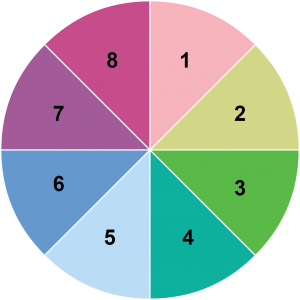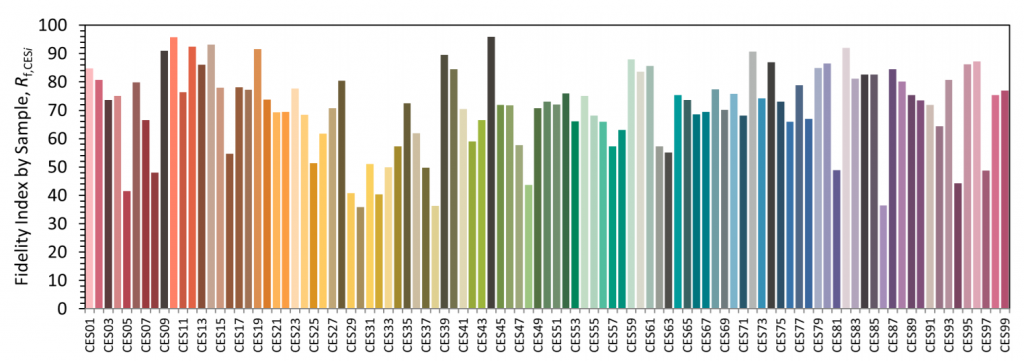A recipe for consistent LED color quality
Above: Use the slider to see the difference a metal halide lamp and Amerlux’s high color quality LEDs.
As any physicist can tell you, color is made of three things: hue, saturation and lightness. But rendering color well with lights requires more than just understanding these elements.
Amerlux’s customers have all kinds of color needs and to meet them, we draw on our expertise in colorimetry, optics, LED phosphor technology as well as a strong industry presence and collaboration to keep up with the constant evolution of lighting.
Poor quality LEDs have tarnished the reputation of LEDs as bright light sources that make colors appear flat and less appealing. The reality is a bit more complicated, however. Spec-grade LEDs should deliver outstanding color quality. Or put another way, lighting should make people feel comfortable and products look great. We have taken color quality to the next level from day one here at Amerlux, delivering the finest color quality.
Here’s our recipe for color quality:
1. The basics: hue, saturation and lightness
Color, as the human eye sees it, is made up of three elements: hue, saturation and lightness. Hue is the dominant wavelength we’re experiencing as color. Saturation (or chroma) is the brilliance and intensity of a color. Low saturation results in pastel color and high saturation gives bright colors. Lightness is the perceived brightness of an object. As light reflects off of an object, we refer to its lightness or darkness. Our eyes can distinguish about 10 million colors and adjustments to these three levers determine which colors we see.
2. The materials science behind LED color quality
Understanding the physics of light and color is a starting point. The next step is materials science.
Part of an LED’s construction is the phosphor layer. This consists of particles that coat the light-emitting die (LED). Depending on the material recipe of the phosphor, you can change how color is rendered under the light.
“We frequently work with clients to develop custom color lighting and this means working closely with our chip manufacturing partners to tweak the phosphor so very specific wave lengths are emphasized,” says Alejandro Guerrero, director of engineering research and development at Amerlux.
The industry uses standard materials in phosphors like red nitride, aluminate and garnet. Introducing new materials into phosphor recipes present technical challenges, such as maintaining quality for the expected life of the luminaire.
“We’ve been driving phosphor innovation to achieve our clients’ color needs—even to the point of developing new, proprietary materials for phosphors,” continues Guerrero.
3. The right measurements and comparisons
Measurement is critical when it comes to defining color quality. The industry is beginning to transition from the old CRI scale to TM-30. CRI delivers a 0 – 100 score where achieving an 80 or better has generally been accepted as “good” color quality.
But a high CRI score doesn’t reveal the full color story. We live in full color and the basis of CRI does not properly represent the color gamut. While CRI is based on eight pastel color reference samples, TM-30 references 99 colors.

The eight colors that the CRI scale measures.
“TM-30 is superior to CRI because it uses 12 times the color references and those colors are plucked from actual objects and reflect real-world applications,” says Guerrero. “The industry is still using CRI, but the color-savvy people are already using TM-30.”
(For more about the differences between TM-30 and CRI, check out our explainer article here)

Above: A sample of the 99 colors the TM30 scale measures. (Image courtesy of Energy.gov)
Regardless of the color scale you use though, Guerrero stresses that it’s vital to compare apples with apples:
“If you have a standard 80 CRI product, but you weren’t sold the right amount of light, you may be underlighting the space or product,” he says. “Compare that light with that of a 70 CRI lamp that has three times the brightness, and the product may look better. The color quality isn’t as good, but you are perceiving it as better due to the lightness factor.”
This is why it is important to compare similar objects under similar lighting conditions for accurate color comparisons.
4. Avoiding color shift
Achieving great color quality is only the first step—the next is to keep it. All artificial light sources shift how they render color over time. Legacy light sources like halogen and metal halide exhibit a larger color shift rather quickly. Besides delivering ultra-long operating lifespans, LEDs can also provide consistent color quality when properly managed thermally, optically and electrically.
Not all LEDs are created equal, and not all LED manufacturers understand how to design for maximum color consistency.
LEDs emit less heat and UV rays than legacy lights, but they do give off heat and those emissions definitely breakdown phosphors over time, bringing about color shift. “To maintain color quality, it’s better to underdrive quality high-power LEDs with a good driver,” says Guerrero. “Engineers need to provide ample color mixing in the optic design to take color shift into account.”
LEDs offer the greatest possibilities the lighting industry has ever seen to impact space design, enhance merchandise and create better environments for people to live, work, play and heal. With solid state lighting technology, we can have it all—perfect color quality, ultra-long operating life and extreme energy efficiency.
Find your perfect color light with a free consultation today.

